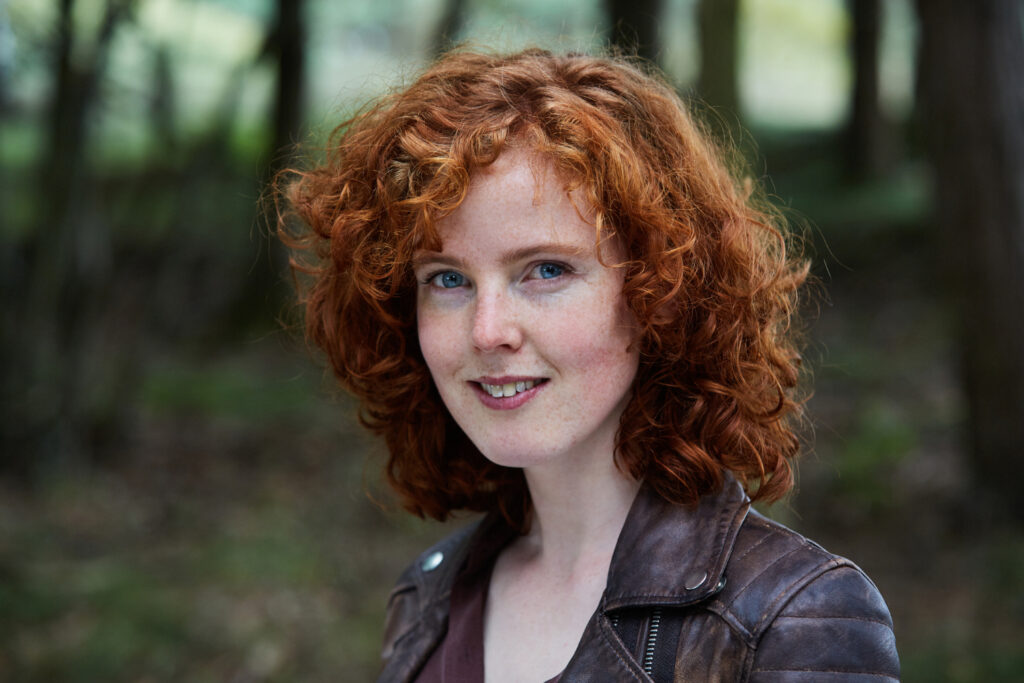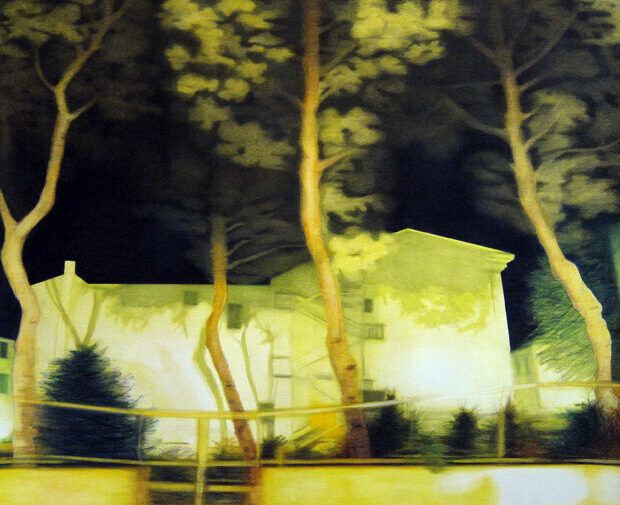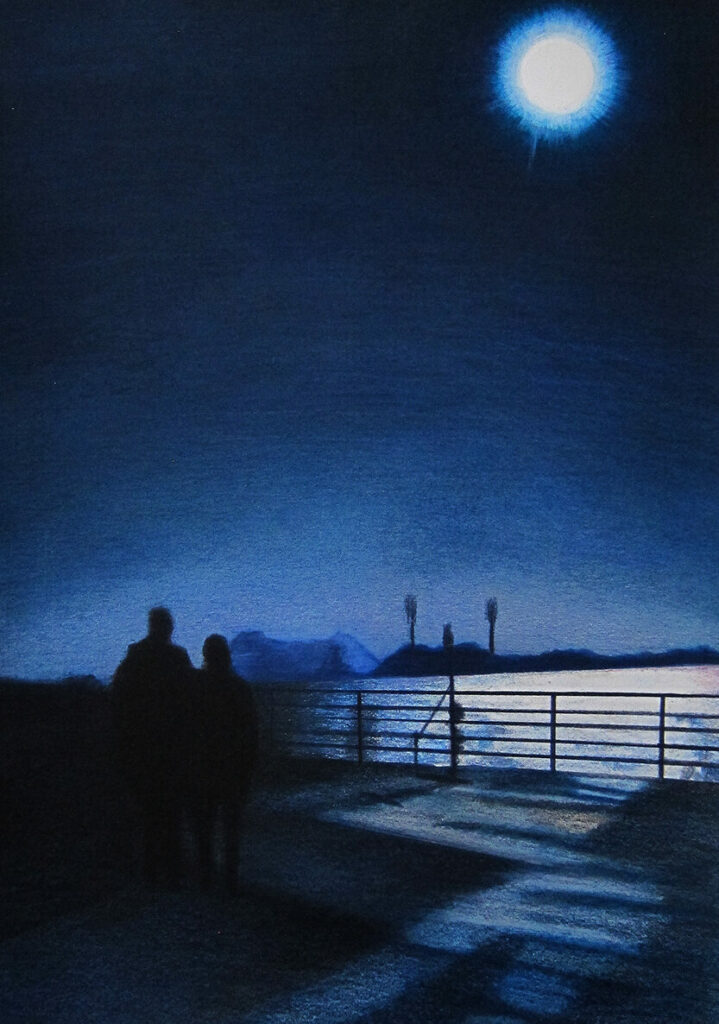Nathalie Duivenvoorden (1988) won the Van Vlissingen Art Foundation Prize in 2015. A fascination for Scandinavia and a desire to see the Northern Lights, prompted Nathalie and her boyfriend to travel to Norway for six weeks for her inspiration trip.
Part of the Inspiration series, the book featuring her work entitled, Nathalie Duivenvoorden in Tromsø, was written by Michiel Didier and published by Waanders. Nathalie’s work was on display in the Rijksmuseum between 10 September and 4 October 2015. Later, Nathalie’s works were displayed at A Gallery Named Sue in The Hague.
Nathalie Duivenvoorden (1988) produces drawings of landscapes. This, she does with precisely-sharpened colored pencils. As a result, her work is rich with color, and light plays an important role in her compositions.
Duivenvoorden’s works explore the concepts of “nature” and “culture. She believes our image of nature in today’s world is a romantic one.. Nature is seen as something pure, a place you like to be, but find yourself outside of. In placing man outside of nature, it creates the idea that man can control it. In some ways, this is true, yet, this attitude places man outside of the complex web of ecosystems. Current climate problems are one of the most extreme consequences of this.
Nathalie goes in search of places “where anything can happen,” things that you don’t see, but must, as a spectator, imagine for yourself. Roughly photographing produces images that contain ‘blind spots’ due to blurriness, black, grainy areas and smudges. Nathalie translates these images with colored pencils, layer upon layer, concentrating on the light., Everyday environments are thus transformed into exciting, poetic images with stories of their own. Through this, Duivenvoorden urges viewers to regain awareness of the contemporary landscape.
During the trip to Norway, Nathalie and her boyfriend took a boat to the North Cape (a trip of no less than 12 hours), the best place to experience the Northern Lights after dark.
“In the end, we saw the very best Northern Lights in town. I also expected the Northern Lights to make noise because the light beams vibrate. But it was completely silent. These moments greatly influenced my drawings and the decision to move to Northern Europe,” she said.
The light, or rather its absence, is what Nathalie has remembered most from the trip to Tromsø. The Northern Lights can only be seen in winter when it remains dark for much of the day. The long walks in the dark in search of the Northern Lights were unforgettable.
Nathalie: “I came back with over 4,000 photos. The trip gave me a lot of new input in a short time and I was able to try out many new things in my pieces—especially in the field of color.” Because the hues and undertones were so different in Norway, Nathalie began to pay more conscious attention to them.
Nathalie: “During the trip, I came to love the northern countries of the world.” Ultimately, this trip resulted in Nathalie moving to a Scandinavian country for a time.

Nathalie Duivenvoorden (1988) produces drawings of landscapes. This, she does with precisely-sharpened colored pencils. As a result, her work is rich with color, and light plays an important role in her compositions.
Duivenvoorden’s works explore the concepts of “nature” and “culture. She believes our image of nature in today’s world is a romantic one.. Nature is seen as something pure, a place you like to be, but find yourself outside of. In placing man outside of nature, it creates the idea that man can control it. In some ways, this is true, yet, this attitude places man outside of the complex web of ecosystems. Current climate problems are one of the most extreme consequences of this.
Nathalie goes in search of places “where anything can happen,” things that you don’t see, but must, as a spectator, imagine for yourself. Roughly photographing produces images that contain ‘blind spots’ due to blurriness, black, grainy areas and smudges. Nathalie translates these images with colored pencils, layer upon layer, concentrating on the light., Everyday environments are thus transformed into exciting, poetic images with stories of their own. Through this, Duivenvoorden urges viewers to regain awareness of the contemporary landscape.
During the trip to Norway, Nathalie and her boyfriend took a boat to the North Cape (a trip of no less than 12 hours), the best place to experience the Northern Lights after dark.
“In the end, we saw the very best Northern Lights in town. I also expected the Northern Lights to make noise because the light beams vibrate. But it was completely silent. These moments greatly influenced my drawings and the decision to move to Northern Europe,” she said.
The light, or rather its absence, is what Nathalie has remembered most from the trip to Tromsø. The Northern Lights can only be seen in winter when it remains dark for much of the day. The long walks in the dark in search of the Northern Lights were unforgettable.
Nathalie: “I came back with over 4,000 photos. The trip gave me a lot of new input in a short time and I was able to try out many new things in my pieces—especially in the field of color.” Because the hues and undertones were so different in Norway, Nathalie began to pay more conscious attention to them.
Nathalie: “During the trip, I came to love the northern countries of the world.” Ultimately, this trip resulted in Nathalie moving to a Scandinavian country for a time.

